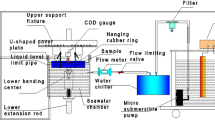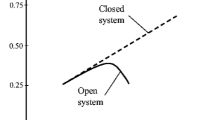Abstract
It has been shown that, for QIN steel specimens tested in seawater at a zero-tension cyclic frequency of 30 cycles per hour, crack growth rates are influenced by crack depth at low values of the stress intensity range (ΔK). Crack growth rates are faster for shallow cracks in the crack depth range 0.5 to 2.0 mm when ΔK is less than about 30 MN m−3/2. For deeper cracks at low stress intensity ranges and for all crack depths at high stress intensity ranges, crack depth does not exert a significant influence on crack growth rate. The implications of such factors in relation to the provision of corrosion fatigue crack growth rate data for use in engineering design are discussed.
Similar content being viewed by others
References
British Standard number BS 5447:1977.
British Standard number BS 5762:1979.
American Society for Testing of Metals Publication number ASTM E 399:74 (American Society for Testing of Metals, Philadelphia, 1974).
American Society for Testing of Metals Publication number ASTM E 647-78T (American Society for Testing of Metals, Philadelphia, 1978).
D. E. McGeachie, M.Phil thesis, University of Southampton (1975).
B. F. Brown,Mater. Res. Stand. 6 (1966) p. 129.
H. H. Johnson andP. C. Paris,Eng. Fracture Mechanics 1 (1968) 3.
P. C. Paris andF. Erdogan,J. Basic Eng., Trans. ASME D85 (1963) 528.
O. Vosikovsky,J. Testing Evaluation 6 (1978) 175.
B. Tomkins, Paper C111/77, Proceedings of the Conference on The Influence of Environment on Fatigue, London, May 1977 (The Institution of Mechanical Engineers, London, 1977).
P. J. E. Forsyth, Proceedings of Crack Propagation Symposium, Cranfield (1961) p.76.
R. J. H. Wanhill,Met. Trans 6A (1975) 1587.
R. Holder, Paper C102/77, Proceedings of the Conference on The Influence of Environment on Fatigue, London, May 1977 (The Institution of Mechanical Engineers, London, 1977).
P. S. Pao, W. Wei andR. P.Wei, in “Environment Sensitive Fracture of Engineering Materials” (edited by Z. A. Foroulis) (TMS-AIME 1979) pp. 565–80.
R. P. Wei, P. S. Pao, R. G. Hart, T. W. Wei andG. W. Simmons,Met. Trans. 11A (1980) 151.
S. Pearson,Eng. Fracture Mechanics 7 (1975) 235.
P. Chauhan andB. W. Roberts,Metall. Mater. Technol. 11 (1979) 131.
R. A. Smith andK. J. Miller,Int. J. Mechanical Sci. 19 (1977) 11.
AMTE, data to be published inlnt. J. Fatigue.
Author information
Authors and Affiliations
Rights and permissions
About this article
Cite this article
Jones, B.F. The influence of crack depth on the fatigue crack propagation rate for a marine steel in seawater. J Mater Sci 17, 499–507 (1982). https://doi.org/10.1007/BF00591484
Received:
Accepted:
Issue Date:
DOI: https://doi.org/10.1007/BF00591484




